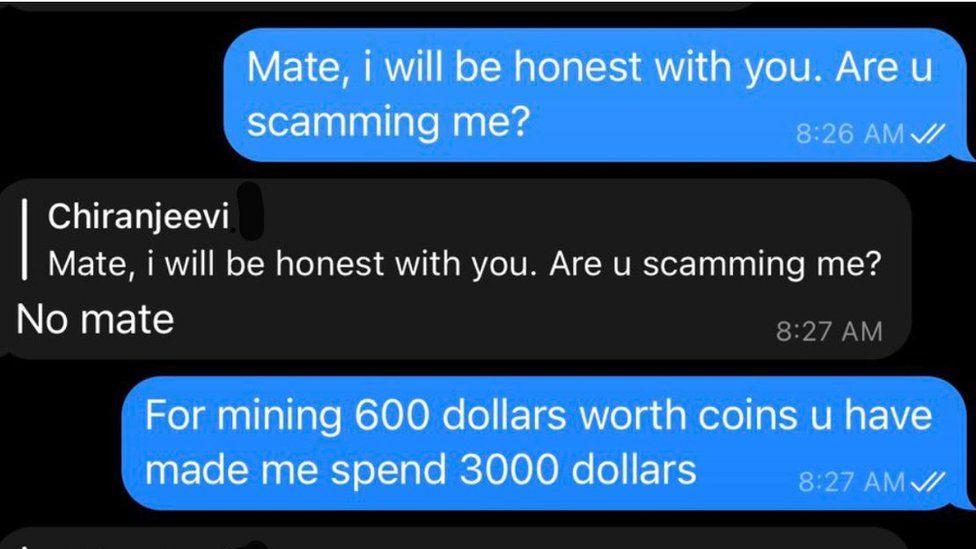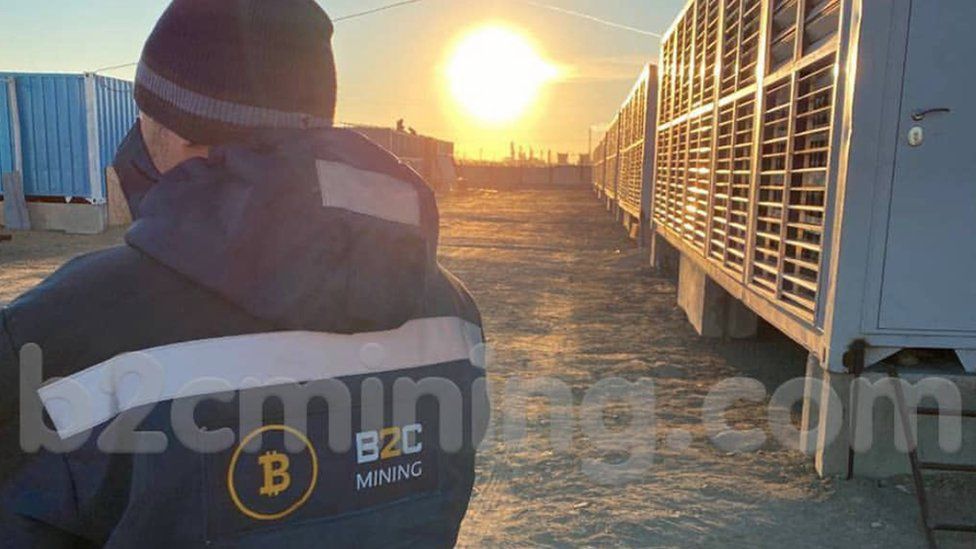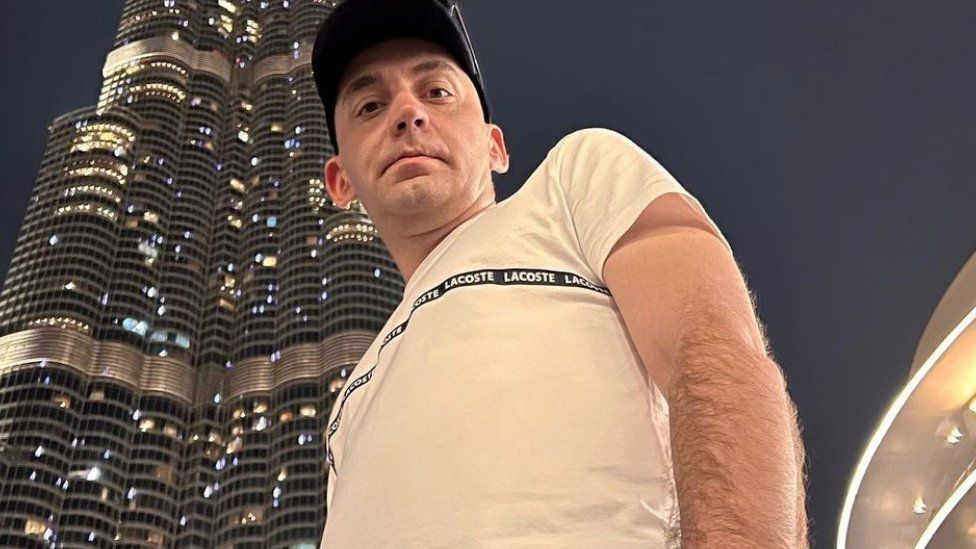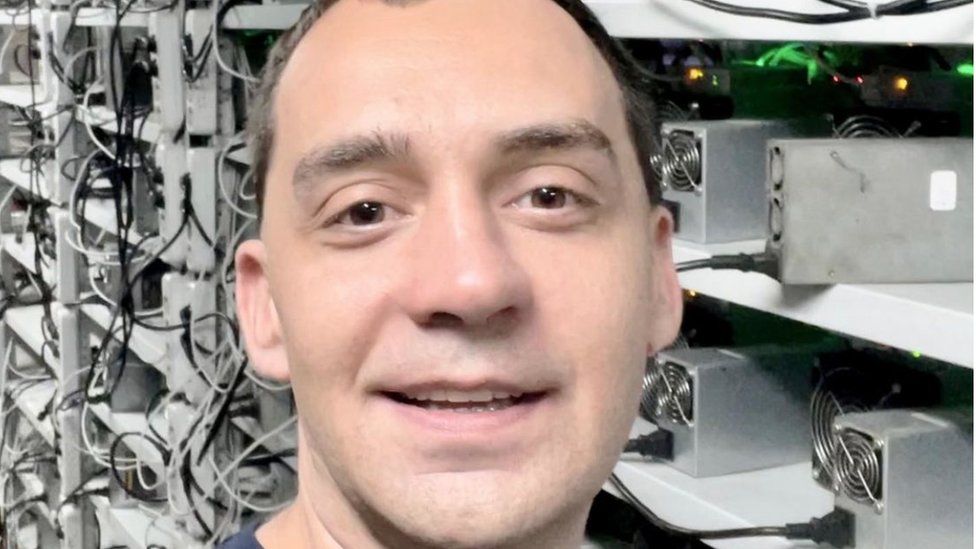Chiranjeevi lives in Hyderabad, India, with his young family.
He is a smiley, glass-half-full kind of guy – naturally positive and full of energy.
He’s smart, too, and works in an Indian tech company.
He’s the least likely person, you’d think, to fall victim to an online scam.
Yet in October he was defrauded out of his life’s savings – $4,000 (£3,000).
He couldn’t believe it.
“I was so stressed. I was just lost. I told my wife and she said, ‘I thought you were intelligent. How did you lose so much money?'”
He messaged me in late October out of the blue, telling me what had happened.
He wasn’t just telling me about the deception, though. He was warning me.
Because central to the scam was a distorted version of my reporting.
Earlier this year I was given access to a Bitcoin mine in New York state. I made a report about it – focused on how mining Bitcoin produces carbon emissions.

However, that is not the report that Chiranjeevi saw.
On 18 October he joined a Telegram channel called B2C Mining.
Telegram is an encrypted messaging service, like WhatsApp, but with “channels”, which can feel more like a Facebook group.
The B2C Mining channel claimed to be part of a company that owned and operated a Bitcoin mine in Russia.
At the top of the group, pinned to the channel, was my report… only it wasn’t quite my report.
It had been altered, cutting out anything to do with climate change, and suggesting that the mine I had reported on was in fact the channel’s.
“I thought it was very genuine,” Chiranjeevi says. “That is what allured me”.
“I thought that you had visited the mining company,” he told me. “I’ve been seeing the BBC since I was a kid, and it has a reputation all over the world.”
There were other videos, too – of happy customers who had made money. People had also posted the gains they had made.
Chiranjeevi was intrigued.
The company claimed to mine crypto-currencies by request – with amazing profits.
“They said they would mine them for 24 hours, and they could make you around 20-to-40%, depending on the type of crypto-coin,” Chiranjeevi said.
The group had nearly 3,000 members. Surely so many people couldn’t be wrong? He decided to give it a whirl.
He began speaking to the channel admin privately – someone who claimed to be the chief executive of B2C Mining – Vadmir Peavsky.
Vadmir Peavsky is not a real person, but we’ll get on to that.
Peavsky told Chiranjeevi that if he were to send him over $160 they would mine a type of crypto-currency for 24 hours.
Twenty-four hours later, his investment was returned with interest. Chiranjeevi had made about $40. He couldn’t believe how simple it was.
“It was easy money,” he says.
Chiranjeevi lives in a flat. He’s comfortable enough. However, he has bigger dreams. He wants to live in a house, and he wants to put his children through university.
Those dreams suddenly seemed attainable. He now had a side hustle, a second income, almost, investing in crypto-mining.
He decided to raise the stakes.
This time he decided to give Peavsky $250 in a crypto-currency called Tron. In five days he was hoping for some hefty returns.
However, as the mining started, Peavsky began to message with bad news. The mining had run into problems. Peavsky needed more money to fix them.
And if Chiranjeevi didn’t pay, he might lose his investment.
“I fell into his trap” he says.
It wasn’t the last request. The problems kept coming. More money was needed to keep the mining going, to save his initial investment. There’s a point in the exchange where you think Chiranjeevi has worked it out…

Chiranjeevi was starting to panic.
But he was in too far. He’d run through his entire savings and was now borrowing money from his family. But even then, he made one last payment, hoping, praying, it was real.
It wasn’t.
“The fallacy of sunk costs, time pressure, good cop/bad cop… It’s a classic scam,” says Jessica Barker, author of Confident Cyber Security.
Barker says Telegram’s end-to-end encryption, combined with a growth in users, has attracted more and more scammers to the platform.
As part of my research into the group I found another man who had been deceived. It took a bit of time for him to speak to me, and he did so on condition of anonymity.
The student, who is 19 and also from India, told me he lost his and his family’s savings.
He wanted to mine at a lower scale, initially with $15.
Peavsky began to pressure him to invest more. “Can’t you borrow money from family and friends?” he said.
Eventually the student did. He promised the people he loved he could give them big returns in exchange for their rupees.
But to his horror, the “just one more” payment requests started coming. If he didn’t pay within a certain time frame, his entire investment was to be forfeited.
He borrowed more money, eventually giving Peavsky $400 – a huge amount to him.
The student began to realise that it was a scam. Terrified, he began to beg Peavsky to give him his money back.
Finally, Peavsky asked him, as if it were a ransom video, to upload a clip of him saying how pleased he was with the service.

It helps to explain why there were so many positive videos on the group channel: some had been made under duress.
The student told me he felt suicidal after that final exchange.
I had many questions about the scam, but the most obvious was: who is Vadmir Peavsky?
I first started with the company that Mr Peavsky claimed to run – B2C Mining. This is a real company, based in Almaty, Kazakhstan. But it’s not run by Vadmir Peavksy.
The company builds Bitcoin mines for clients, and repairs machinery. Some of their pictures and branding had been used on the Telegram channel.
“We don’t have any Telegram channels and we don’t sell any crypto-currency,” Vladimir Ligai, who works at the company, told me.
The scammers used this picture, taken from social media, claiming it was part of their mine. They also used the B2C logo and name.

He says he’d never heard of Vadmir Peavsky.
That may well be because Vadmir Peavsky is not a real name.
We know that, because the pictures of Mr Peavsky used on the Telegram channel actually belong to a man called Vladimir Paevskiy – a subtle but important difference in spelling.

Vladimir Paevskiy is real. He’s 34 and from Moscow. He is a crypto-investor and has more than one million followers on Instagram. He regularly shares pictures of himself standing in front of crypto-mining equipment.
I eventually managed to speak to him.
Vladimir Peavskiy told the BBC his identity had also been taken by the scammers.
“The scammers have taken my pictures from Instagram,” he says.

So who took Vladimir Paevskiy’s identity?
Both of the scam victims I spoke to paid Peavsky using different crypto-currencies.
To do this, they needed to send the money into the scammer’s digital wallet, which has a specific ID number.
“Frank” works for Whale Alert, an organisation that monitors crypto-transactions. He’s an expert at monitoring and analysing crypto-scams. He’s asked us not to use his surname.
“These are not pros,” says Frank.
They had used the same wallet over and over again, some 60 payments being made into one account alone.
In total, he found $25,000 had been scammed by the group. There’s likely to be more that Frank could not find, too.
The scammers were making money but they had been sloppy.
The group redirected the crypto they had convinced people to pay them into several crypto-exchanges, where the currencies can be swapped for cash.
Two of the exchanges were based in India – bitbns.com and wazirx.com.
“Why would anybody from Russia transfer to an Indian exchange to trade crypto for rupees?” Frank says. “My guess is that these scammers are not from Russia, but from India.”
“Peavsky is almost certainly not one person. It is an organised criminal gang,” he says.
Chiranjeevi always thought he was talking to a Russian. The scam was so convincing that even now when you tell him that Peavsky isn’t a real person, he can’t quite believe it.
That the scammers are likely to be from India is good news for the victims.
“In theory, there is no reason that the Indian authorities can’t find these people and the money be returned,” says Frank.
The information Frank collected has been handed over to the national cyber-crime department of the Indian Ministry of Home Affairs.
These kinds of scams can have devastating impacts on victims and families. And the scale at which they operate is vast.
The day I interviewed Frank, he had personally seen $58,000 being sent to suspect crypto-wallets. It is fraud on an industrial scale.
Chiranjeevi still can’t believe he was scammed. Such was the stress he was under during the five-day mining process, he says he was almost relieved when he finally worked out it was a scam.
“My wife forgave me,” he says.
Not all families and friends are so understanding.
As for the student, he says he is no longer suicidal, but he hasn’t told the people he borrowed from that he’s lost their money.
He’s now working evenings to try to earn the money to pay them back. He says it’s affecting his studies, but what can he do? He has no choice.
You can listen to the radio documentary about this investigation,‘The Fake Bitcoin Mine’ here:
James Clayton is the BBC’s Silicon Valley correspondent. His Twitter handle is @jamesclayton5


